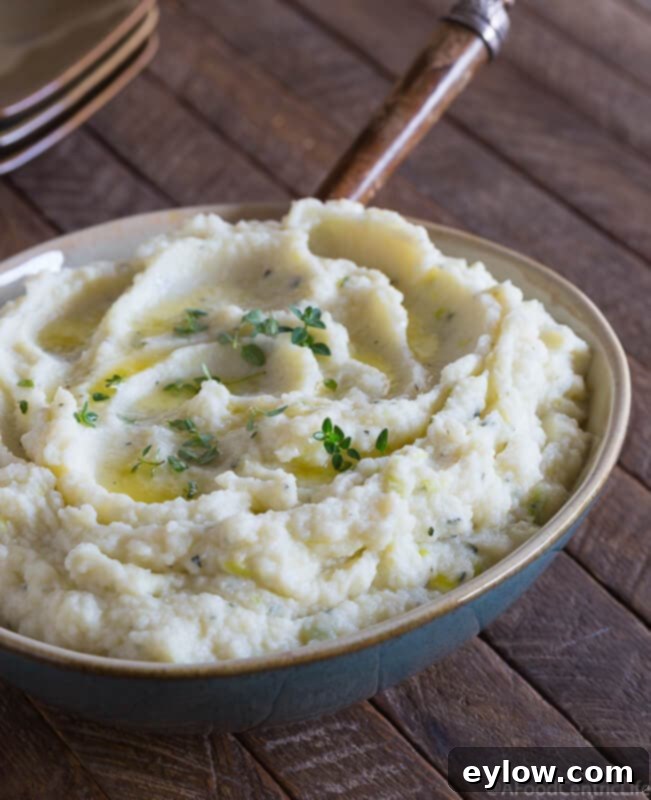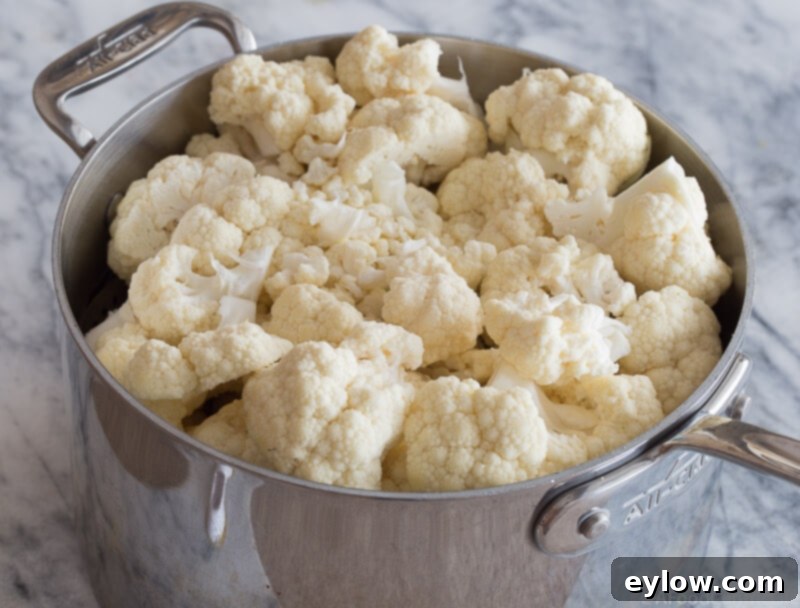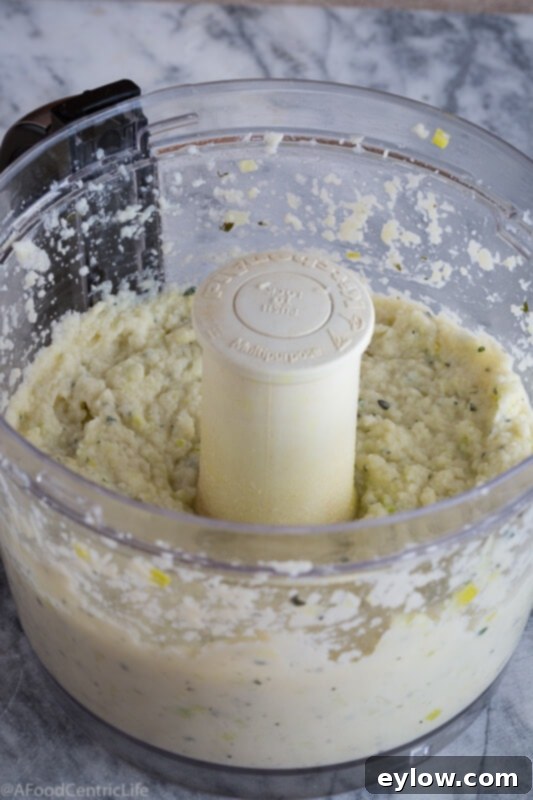Creamy Cauliflower Puree: Your Ultimate Low-Carb Mashed Potato Alternative
If you’re embracing a low-carb lifestyle but find yourself longing for the comforting creaminess of mashed potatoes, then this delicious creamy cauliflower puree recipe is about to become your new favorite side dish. It offers all the rich, smooth texture you crave without the high carbohydrate count, making it a perfect fit for keto, paleo, or simply healthier eating plans. My unique recipe elevates the flavor profile by incorporating sautéed leeks and garlic, alongside the fresh, aromatic boost of chopped thyme leaves. This combination transforms simple cauliflower into an elegant and incredibly satisfying dish that stands proudly on its own.
Beyond its incredible taste, this creamy cauliflower puree is remarkably versatile and convenient. You can easily prepare it in advance, making it an ideal solution for busy weeknight dinners when time is short, or as a sophisticated and healthier alternative to traditional mashed potatoes on your festive holiday table. Its ability to reheat beautifully means you can enjoy gourmet flavor with minimal fuss, any day of the week.

Cauliflower: A Nutritional Powerhouse and Health Star
Cauliflower isn’t just a low-carb alternative; it’s a nutritional powerhouse, making it one of the healthiest vegetables you can incorporate into your diet. As a proud member of the cruciferous vegetable family, alongside nutritional giants like broccoli, kale, cabbage, collard greens, and Brussels sprouts, cauliflower is packed with an impressive array of vitamins, minerals, and dietary fiber. It is an excellent source of Vitamin C, crucial for immune health and skin integrity, and also provides a good amount of Vitamin K, vital for blood clotting and bone health, as well as folate, important for cell growth and function.
What truly sets cauliflower apart is its abundance of powerful plant compounds known as phytonutrients. It contains unique sulfur-containing compounds called glucosinolates and isothiocyanates. These compounds are renowned for their potent anti-inflammatory properties, which can help combat chronic inflammation throughout the body. Furthermore, research suggests that these phytonutrients play a significant role in detoxification processes and may offer protection against certain types of cancer. Regular consumption of cauliflower contributes to overall well-being, supporting a healthy digestive system due to its fiber content, and providing antioxidants that fight oxidative stress.

Cauliflower Versus Potatoes: The Low-Carb Advantage
When it comes to managing carbohydrate intake, the difference between cauliflower and potatoes is striking, positioning cauliflower as the clear winner for those following low-carb diets. Potatoes, particularly a medium gold potato, are considered a medium glycemic food with a glycemic index (GI) rating of 58. A standard 5-ounce serving of gold potatoes contains approximately 26 grams of carbohydrates, which can lead to a significant spike in blood sugar levels. For individuals monitoring their blood sugar, managing weight, or adhering to specific dietary restrictions like ketogenic or diabetic diets, this carb count can be a considerable concern.
In stark contrast, a 5-ounce serving of low-glycemic cauliflower contains less than 7 grams of carbohydrates and boasts a glycemic index rating of just 15. This substantial difference makes cauliflower an exceptionally suitable substitute for potatoes, allowing you to enjoy a satisfying, starchy-like side dish without derailing your low-carb goals. Opting for cauliflower puree helps stabilize blood sugar, supports weight management efforts, and provides sustained energy without the subsequent crash often associated with high-carb foods. It’s a smart, health-conscious choice that doesn’t compromise on flavor or texture.

How to Make Perfect Creamy Cauliflower Puree: A Step-by-Step Guide
Creating this velvety, flavorful cauliflower puree is simpler than you might think. For the freshest taste and best texture, I always recommend buying a whole head of cauliflower rather than pre-cut bagged florets. Trimming it yourself ensures maximum freshness and often provides better value. If you’re new to breaking down a whole head of cauliflower, it’s quite easy. Just watch my quick video here for a visual guide. A typical three-pound head of cauliflower will yield approximately two and a half pounds of florets, which is perfect for serving 6-8 people. Don’t worry if your heads are smaller; simply buy two. Any leftovers are a bonus, as this creamy puree reheats beautifully!
Once you have your cauliflower, begin by trimming the florets into medium-sized chunks. These uniform pieces will ensure even cooking. Next, steam the cauliflower in a 5-6 quart pan equipped with a steamer rack. The key to a truly creamy puree is cooking the cauliflower until it is exceptionally tender – you should be able to pierce it easily with the tip of a sharp paring knife. This usually takes about 12-15 minutes of steaming. While the cauliflower is steaming, prepare your aromatics. Sauté the sliced leeks and finely chopped garlic in a little olive oil until they are soft and fragrant. This step is crucial for developing the deep, savory notes that elevate this puree beyond a simple mashed vegetable.
After the cauliflower is perfectly tender, transfer it immediately to a food processor. Add the sautéed leeks and garlic, fresh thyme leaves (or parsley if preferred), a generous pat of butter (or ghee for a dairy-free option), salt, and pepper. Begin to puree, gradually adding a few tablespoons of chicken or vegetable broth. The broth helps achieve a silkier, creamier consistency without adding too much fat or altering the flavor. Blend until the puree is incredibly smooth and free of lumps. Taste and adjust seasonings as needed. For an extra luxurious finish, you can add a splash of heavy cream or cream cheese during the pureeing process. Serve hot and enjoy this delightful low-carb sensation!

Make It Ahead and Re-Heat: Convenience for Busy Lives
One of the many benefits of this creamy cauliflower puree is its fantastic make-ahead potential, making it a perfect meal prep component for your busy schedule. You can prepare the puree up to 3 days in advance. Once it’s made, allow it to cool completely before transferring it to an airtight container. Refrigerate it tightly covered to maintain its freshness and flavor. This means you can enjoy a gourmet side dish with minimal effort during the week or have it ready for entertaining.
Reheating is simple and ensures your puree returns to its creamy best. For stovetop reheating, place the desired amount of puree in a medium pan. Add a tablespoon or two of chicken or vegetable broth, milk, or even a pat of butter to help restore moisture and creaminess. Heat over medium-low heat, stirring occasionally, until it’s thoroughly warmed through. Alternatively, you can use a microwave: place the puree in a microwave-safe bowl, add a splash of liquid, cover, and heat in 1-minute intervals, stirring between each, until hot. For a festive touch or just extra indulgence, drizzle a little extra melted butter or ghee over the top just before serving. This not only adds richness but also enhances the presentation.
More Cauliflower Ideas: Explore Its Culinary Versatility
The world has truly gone “cauliflower crazy,” and for good reason! This humble vegetable is incredibly versatile and can be transformed into countless delicious dishes. Its mild flavor and adaptable texture make it an excellent ingredient for both savory and even some surprisingly sweet applications. Here are a few more ways to incorporate cauliflower into your diet:
- **Smoothies:** Yes, you read that right! For an extra fiber and veggie boost without altering the taste, try adding raw, frozen cauliflower florets to your morning smoothie. It blends seamlessly and adds a wonderful creamy texture. Here is the recipe for my strawberry banana smoothie with frozen cauliflower.
- **Cauliflower Rice:** A fantastic low-carb alternative to traditional grain rice. It’s quick to prepare and can be flavored in endless ways. Serve it as a base for stir-fries, curries, or simply as a side dish. Check out this post for cauliflower rice with parmesan and herbs.
- **Roasted Cauliflower:** Roasting brings out cauliflower’s natural sweetness and gives it a delightful nutty flavor. It’s simple, wholesome, and makes an excellent side dish. Learn how to roast cauliflower perfectly.
- **Cauliflower Steaks:** Thick slices of cauliflower can be roasted or grilled until tender and charred, creating a hearty vegetarian main course. Season them with herbs, spices, or a rich marinade for a flavorful meal.
- **Buffalo Cauliflower Bites:** A popular appetizer, these florets are breaded (often with almond flour for low-carb) and baked until crispy, then tossed in a spicy buffalo sauce. A guilt-free way to enjoy a classic pub snack!
- **Cauliflower Pizza Crust:** For a gluten-free and low-carb pizza option, a cauliflower crust is a game-changer. It holds up well to toppings and satisfies those pizza cravings without the heavy carbs.
- **Cauliflower Soup Base:** Pureed cauliflower can add incredible body and creaminess to soups, making them thicker and more satisfying without needing heavy cream or flour. It’s a secret ingredient for a healthier, heartier soup.
Embrace the versatility of cauliflower and experiment with these ideas to keep your meals exciting, healthy, and incredibly flavorful!

Calories from Fat 81
📖 Recipe

Creamy Cauliflower Puree
Sally Cameron
Pin Recipe
Equipment
-
Food Processor
Ingredients
- 1 3-pound head cauliflower or 2 ½ pounds florets
- ½ leek white and pale green part only
- 2 teaspoons extra virgin olive oil
- 3-4 garlic cloves chopped fine
- 4 tablespoons unsalted butter, ghee, or plant-based butter
- 2 teaspoons fresh chopped thyme leaves or parsley, optional
- 2 tablespoons chicken or vegetable broth
- ¼ teaspoon sea salt
- ¼ teaspoon ground pepper I use white pepper
Instructions
-
Trim the head of cauliflower into florets. Cut all the way around the center core with a sharp paring knife. Break florets off by hand. If needed, cut them into smaller florets that will fit in your steamer.
-
Add a few inches of water to a large 5-6 quart pot. Place steamer rack inside the pot. Water should come to the bottom of the rack. Turn heat to high and cover pot with a tight fitting lid. When water is steaming, add the cauliflower, cover and turn to medium-low. Steam florets until very tender when pierced with the tip of a sharp paring knife, 12-15 minutes.
-
While cauliflower is steaming, cook the leeks. Slice the leek in half and run under cold water to dislodge any sandy grit. Dry leek and chop crosswise into thin pieces. Heat oil in a medium fry pan over medium low heat adn cook leek until soft and tender, 2-3 minutes then add the garlic and cook another 30 seconds.
-
Add cauliflower, leeks and garlic to the work bowl of a food processor and puree, adding the butter, thyme, salt and pepper. Add the broth at the end to adjust creaminess. Serve hot or cool, cover and refrigerate up to 3 days, then reheat to serve.
